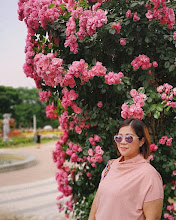Here is a guide to some of the best festivals that will make your spring trip to Korea even more memorable. If you're visiting the country during these times, do seek them out and enjoy the spirit of rebirth, renewal, and rejuvenation, which is exactly what spring is all about.
Goryeosan Mountain Azalea Festival (April 13 - 21, 2019)
 |
| Goryeosan Mountain Azalea Festival. |
During the Azalea Festival, several walking/hiking courses are offered to visitors, all between 1 to 2 hours long. You'll walk through a myriad of pink and purple flowers to reach the peak of the mountain, and get to enjoy the breathtaking scenery of the West Sea and a glimpse of the North Korean coastline.
To get to Goryeosan, take the subway to Sinchon on Line 2 and leave exit 4. Go straight for about 260m to arrive at the bus stop in front of Arteon. Take bus 3000 for about 2 hours to Ganghwa bus terminal. From the bus terminal take bus 1,23,25,27,30,32 or 35 and get off at Dolmen Square. Follow all the hikers to Goryeosan
Taean International Tulip Festival (April 14 - May 12, 2019)
 |
| Colorful tulips at the Taean International Tulip Festival. |
This festival is recognized by the World Tulip Summit Society and takes place at the Korea Flower Park a 30-acre flower theme park where you can walk among gorgeous spring flowers and enjoy the beautiful glow of the Taean sunset.
To get there, head to Dong Seoul Bus Terminal and take an intercity bus to Taean. From Taean Intercity Bus Terminal, take a village bus bound for Gomseom and get off at Morenon Bus Stop.
Royal Culture Festival (April 27 - May 5, 2019)
One of my favorite cultural festivals in Seoul, the Royal Culture Festival is the perfect opportunity for tourists to learn more about Korea's royal palaces and delve deeper into Korean culture. During the festival, Gyeongbokgung Palace, Changdeokgung Palace, Changgyeonggung Palace, Deoksugung Palace, and Jongmyo Shrine are open to the public for free, and host an array of cultural programs, performances, exhibitions, and experience zones. Some of these palaces will be open until night time, though the special evening admissions come with a small fee.
This year's Royal Culture Festival promises to be a very exciting one as it aims to present Korea's rich history and culture through state-of-the-art technology. A special augmented reality (AR) game will be available at Changdeokgung Palace during the nine-day event, while Gyeongbokgung Palace will host a performance chronicling the Gyeonghoeru pavilion’s construction process using 3D technology. And for the first time since the festival's inception, Gyeonghuigung Palace will join in the revelry and will host traditional dance performances using robots.
Locations and how to get there:
Gyeongbokgung Palace - Gyeongbokgung Station (Seoul Subway Line 3)
Changdeokgung Palace - Take Bus 100, 102, 104, 90S tour bus or 91S tour bus.
Changgyeonggung Palace - Take Bus 100, 102, 104, 90S tour bus or 91S tour bus.
Deoksugung Palace - City Hall Station (Seoul Subway Line 1 or 2)
Jongmyo Shrine - Jongno 3(sam)-ga Station (Seoul Subway Line 1, 3 or 5).
Lotus Lantern Festival (May 3-5, 2019)
A prelude to Buddha's birthday, the Lotus Lantern Festival (Yeong Deung Hoe) is one of the most celebrated events in Korea. It's also one of the oldest festivals, with a history spanning over 1200 years. Originally an event with Buddhist significance, this occasion has now become a cultural festival celebrated by everyone in Korea.
Traditional lanterns in various colors, shapes, and sizes are hung all over downtown Seoul, and both Bongeunsa and Jogyesa temples host various cultural performances for locals and tourists to enjoy.
The highlight of this festival is the Lantern Parade, where thousands of lanterns illuminate the metropolis and create an illusion of stars streaming through the milky way. In the previous years, more than 300,000 Koreans and 50,000 foreigners have participated in this event, and is said to be the biggest of its kind in the world.
 |
| Gyeongbokgung Palace at night. |
 |
| Promotional poster for the 2019 Royal Culture Festival. |
Locations and how to get there:
Gyeongbokgung Palace - Gyeongbokgung Station (Seoul Subway Line 3)
Changdeokgung Palace - Take Bus 100, 102, 104, 90S tour bus or 91S tour bus.
Changgyeonggung Palace - Take Bus 100, 102, 104, 90S tour bus or 91S tour bus.
Deoksugung Palace - City Hall Station (Seoul Subway Line 1 or 2)
Jongmyo Shrine - Jongno 3(sam)-ga Station (Seoul Subway Line 1, 3 or 5).
Lotus Lantern Festival (May 3-5, 2019)
 |
| Lanterns in Jogyesa Temple. |
Traditional lanterns in various colors, shapes, and sizes are hung all over downtown Seoul, and both Bongeunsa and Jogyesa temples host various cultural performances for locals and tourists to enjoy.
 |
| Photo credit: Korea.net. |
To get to Bongeunsa Temple, take Samseong Station (Line 2) Exit 6. Walk straight for approximately 600m, and turn left. Walk straight for approx. 150m to arrive at Bongeunsa Temple
To get to Jogyesa Temple, take Jonggak Station (Line 1) Exit 2. Walk straight for about 200m to arrive at Jogyesa Temple.
Boseong Green Tea Festival (May 2-6, 2019).
 |
| The picturesque hillside of Boseong. |
In the spring, these seemingly endless fields of green welcome visitors from all over the country to the Boseong Green Tea Festival, a celebration of the town's booming green tea industry and rich cultural heritage. Various programs and workshops are scheduled during this five-day event, but the hands-on activities such as picking tea leaves, making tea, and preparing green tea snacks are the real crowd favorites.
How to get to Boseong:
From Seoul Express Bus Terminal, take an intercity bus to Boseong (보성) or to Gwangju (광주). From the Boseong Bus Terminal, take a Boseong-Gunhak (보성-군학) route bus to Daehan Dawon (대한다원). From Gwangju U-Square Bus Terminal, take an intercity bus to Boseong (보성).
Hangang Seoraeseom Canola Festival (May 11-16, 2019)
 |
| A sea of yellow at Seoraeseom Island. |
At Seoraeseom Island, a small (artificial) island located between Dongjakdaegyo Bridge and Banpodaegyo Bridge, you'll find canola flowers blooming in full glory by mid-May. The Hangang Seoraeseom Canola Festival is held around this time, and gives visitors the opportunity to capture beautiful memories of spring. During the festival, visitors can enjoy many photo zones, culture and art performances, and hands-on activities all over the island.
To get there, take Gubanpo Station (Seoul Subway Line 9), Exit 2. Go 370m towards the Olympic-daero Highway. Follow the street signs for Hangang Park to arrive at Banpo Seoraeseom Island.
Seoul Grand Park Rose Festival (May 25 - June 9, 2019)
 |
| Roses in full bloom. |
The Seoul Grand Park Rose Festival usually kicks off in the last week of May until the first week of June, and is held at the botanic garden of the Seoul Grand Park. Visitors will marvel at the beauty and splendor of more than ten million roses sprawled across the 10-acre garden. Workshops, concerts, and cultural events are some of the highlights of this annual event, and these activities are all free of charge.
 |
| At least year's Seoul Grand Park Rose Festival. |
Ready to experience the beauty of spring? Which festivals are included in your itinerary?














.jpg)




10 replies:
Nice reading the post about the Spring festivals in Korea. The photos look alluring.
Omg ive always wanted to visit korea and each festival looks better than the last! I especially love the roses so pretty!
I know there is more to Korea that I can't get enough. Korea is my dream country and this guide has given me more reason to love Korea. Thanks for sharing.
really want to be in seoul to witness these festivals and have a great time
Wow, these all look like they would be great to go too. I haven't been to any of them but I want to forsure.
this looks fabulous and serene!!! I would love to do this!
WOWWWWWW!!! You are so lucky to experience all these spring festivals! I can only dreammmm! One day One day!
Korea is in my bucket list. I think I will love it. Festivals make the trip even more tempting
I always wanted to go to korea in sprimg season, foing to these festivals will surely be on my bucket lest
This is so beautiful I wish i could Travel here soon!
Post a Comment